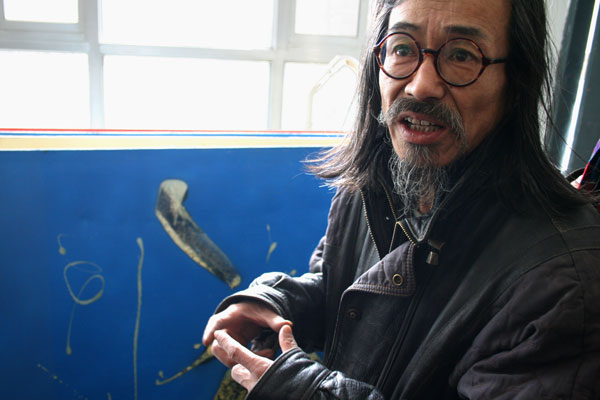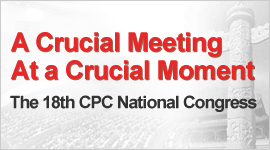The lives of artists in Songzhuang
- By William Wang
 0 Comment(s)
0 Comment(s) Print
Print E-mail CRI, March 14, 2013
E-mail CRI, March 14, 2013
|
Artist Yu Fu describes his art in his Songzhuang studio/home. [Photo: CRIENGLISH.com/William Wang] |
Art hype in China is sharply focused on Beijing's 798 Art District, though a growing number of artists and visitors are disappointed in how the area has become commercialized. Up-and-coming artists were once drawn to 798 because its disused factory spaces were easily converted to artist studios, and the rents were dirt cheap. As rents in 798 shot up, many artists turned to the growing southeastern Beijing suburb of Songzhuang.
Songzhuang gained some notoriety early in the '90s when artist celebrities Fang Lijun and Yue Minjun set up shop there. Around that time, developers and even the central government realized the profits Chinese avant-garde art could generate, thus injecting millions of yuan into developing this farmer's village. Songzhuang has clearly transformed into something new, but whether or not its aspirations are being reached is a contentious debate.
Today, the number of artists working or living in Songzhuang is reportedly 6,000. The main avenues are lined with curvaceous and angled modern and minimalist architecture: galleries and studio spaces. It is an artistic environment that lacks one thing: people.
The streets and galleries appear deserted. Six thousand artists there may be, but apparently they choose to close themselves up in their studios. That is, of course, the reason they came here.
Gulistan is a painter who teaches art at Capital Normal University. Her Songzhuang studio is a tall, white space with multiple level lofts, a slick condo which she designed herself. Paintings hanging throughout provide a timeline to her career, from her studies of Rembrandt to her recently completed series which all somehow look uncompleted.
"I'm not so very social," she said coyly, before adding, "I don't like to come to Songzhuang because there are too many artists."
By Beijing standards, the 70,000 yuan annual rent for such a space is completely reasonable, though it's clear that many Songzhuang artists don't dare dream of having such a studio of their own.
Thousands of others reside in traditional single story homes, where the chill sneaks in through the windows and doors.
Yu Fu is a 50-year-old painter who has been living in one of these Songzhuang homes for longer than most. "I've been in Songzhuang for six years so I'm an old hand around here!" he smiled. His bedraggled beard and mop of hair place him somewhere between artsy and low income.
His abstract paintings reference Chinese calligraphy and the sandstorms of Ningxia, where he grew up. His unique mix of paint and inks results in some impressively delicate and organic textures expressed upon bold forms over boldly blank backdrops. He looks like he could be one of Songzhuang's talented starving artists.
"He's not outgoing so he can't make himself known to the public," commented his daughter, Wang Ge, who often speaks on his behalf. She believes that because her father is hard of hearing it's even more difficult for him to sell himself; it's true that people sometimes have trouble deciphering his meaning. To make matters worse, Yu Fu's past manager appeared to be completely inadequate at promoting his work. "That manager didn't support this kind of art so much," complained Wang. "The manager wanted to deal with big markets and because there's not a lot of art in this style, he didn't want to support him."
Yu knows his work isn't mainstream, describing it as "not elegant" or even "crude." He may be victim of an inattentive market, but it doesn't seem to weigh on him. Remarkably, he claims to have no idea how much his paintings are worth. "Someone else can sell the work. I don't do that. I never think about the price. I just paint. Nothing else."
And Songzhuang at least is a place for people to paint. Luo Minli has been painting in Songzhuang for four years, interpreting "mystery in the east" via western expressionism. "It's so troublesome living in the city," he began. "City life pulls us away from art. This place is quieter so we can focus on our work. If I lived in the city, I'd be troubled by things which aren't related to art."
Luo's sentiments are echoed by multitudes of residents who have little interest in Songzhuang except as a place to create. As a place to sell, however, it's far from ideal. Chinese collectors visit more than international ones, but this crowd of China's newly wealthy is usually focused on traditional Chinese art. Attention from the west remains more progressive but the attention has declined over the last two years. Some people believe that the economic crisis has cut interest in Songzhuang, but others believe the main reason is less obvious.
Wu Jingbo runs a small gallery called Jin Mu Shui Huo Tu. According to him, the development of Songzhuang has resulted in less freedom of expression. In turn, "western art organizations have become less and less interested in Songzhuang."
Wu glanced out at the windstorm blasting at the gallery windows, the sky, hazy with sand. "The situation for the frontline of Chinese modern art," he opined, "is like the weather today."
Songzhuang Getting there: From Tongzhou Beiyuan subway station (Batong Line), take a 20 minute taxi ride east to Songzhuang.








Go to Forum >>0 Comment(s)